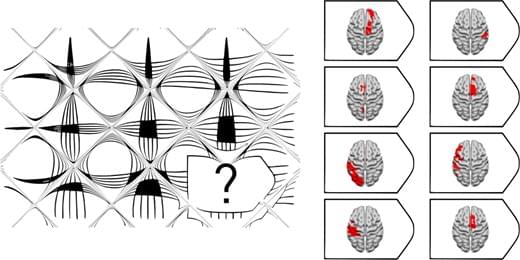Fluid intelligence refers to the ability to solve challenging novel problems when prior learning or accumulated experience are of limited use. 1 Fluid intelligence ranks amongst the most important features of cognition, correlates with many cognitive abilities (e.g. memory), 2 and predicts educational and professional success, 3 social mobility, 4 health 5 and longevity. 6 It is thought to be a key mental capacity involved in ‘active thinking’, 7 fluid intelligence declines dramatically in various types of dementia 8 and reflects the degree of executive impairment in older patients with frontal involvement. 9 Despite the importance of fluid intelligence in defining human behaviour, it remains contentious whether this is a single or a cluster of cognitive abilities and the nature of its relationship with the brain. 10
Fluid intelligence is traditionally measured with tests of novel problem-solving with non-verbal material that minimize dependence on prior knowledge. Such tests are known to have strong fluid intelligence correlations in large-scale factor analyses. 11, 12 Raven’s Advanced Progressive Matrices 13 (APM), a test widely adopted in clinical practice and research, 14 contains multiple choice visual analogy problems of increasing difficulty. Each problem presents an incomplete matrix of geometric figures with a multiple choice of options for the missing figure. Less commonly, verbal tests of fluid intelligence such as Part 1 of the Alice Heim 4 (AH4-1) 15 are adopted. The Wechsler Adult Intelligence Scale (WAIS) 16 has also been used to estimate fluid intelligence by averaging performance on a diverse range of subtests. However, several subtests (e.g. vocabulary) emphasize knowledge, disproportionately weighting measures of ‘crystallized’ intelligence, 17, 18 whilst others (e.g. picture completion) have rather low fluid intelligence correlations. 19 Hence, it has been argued that tests such as the APM are the most suitable for a theoretically-based investigation of changes in fluid intelligence after brain injury. 20, 21
Proposals regarding the neural substrates of fluid intelligence have suggested close links with frontal and parietal functions. For example, Duncan and colleagues 22 have argued that a network of mainly frontal and parietal areas, termed the ‘multiple-demand network’ (MD), is ‘the seat’ of fluid intelligence. The highly influential parieto-frontal integration theory (P-FIT), based largely on neuroimaging studies of healthy subjects, posits that structural symbolism and abstraction emerge from sensory inputs to parietal cortex, with hypothesis generation and problem solving arising from interactions with frontal cortex. Once the best solution is identified, the anterior cingulate is engaged in response selection and inhibition of alternatives. 23, 24 Despite its name, P-FIT also posits occipital and temporal involvement, implying widely distributed substrates of fluid intelligence.









Comments are closed.